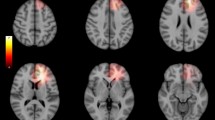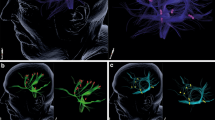Abstract
Despite a better understanding of their anatomy, the functional role of frontal pathways, i.e., the fronto-striatal tract (FST) and frontal aslant tract (FAT), remains obscure. We studied 19 patients who underwent awake surgery for a frontal glioma (14 left, 5 right) by performing intraoperative electrical mapping of both fascicles during motor and language tasks. Furthermore, we evaluated the relationship between these tracts and the eventual onset of transient postoperative disorders. We also performed post-surgical tract-specific measurements on probabilistic tractography. All patients but one experienced intraoperative inhibition of movement and/or speech during subcortical electrostimulation. On postoperative tractography, the subcortical distribution of stimulated sites corresponded to the spatial course of the FST and/or FAT. Furthermore, we found a significant correlation between postoperative worsening and distances between these tracts and resection cavity. A resection close to the (right or left) FST was correlated with transitory motor initiation disorders (p = 0.026), while a resection close to the left FAT was associated with transient speech initiation disorders (p = 0.003). Moreover, the measurements of average distances between resection cavity and left FAT showed a positive correlation with verbal fluency in both semantic (p = 0.019) and phonemic scores (p = 0.017), while average distances between surgical cavity and left FST showed a positive correlation with verbal fluency scores in both semantic (p = 0.0003) and phonemic modalities (p = 0.037). We suggest that FST and FAT would cooperatively play a role in self-initiated movement and speech, as a part of “negative motor network” involving the pre-supplementary motor area, left inferior frontal gyrus and caudate nucleus.







Similar content being viewed by others
Abbreviations
- FAT:
-
Frontal aslant tract
- IQR:
-
Inter quantile range
- FST:
-
Fronto-striatal tract
- SMA:
-
Supplementary motor area
- WHO:
-
World Health Organization
- VOI:
-
Volume of interest
References
Ackermann H, Riecker A (2011) The contribution(s) of the insula to speech production: a review of the clinical and functional imaging literature. Brain Struct Funct 214:419–433
Alexander GE, Crutcher MD (1990) Functional architecture of basal ganglia circuits: neural substrates of parallel processing. Trends Neurosci 13:266–271
Alexander MP, Benson DF, Stuss DT (1989) Frontal lobes and language. Brain Lang 37:656–691
Amunts K, Weiss PH, Mohlberg H, Pieperhoff P, Eickhoff S, Gurd JM, Marshall JC, Shah NJ, Fink GR, Zilles K (2004) Analysis of the neural mechanisms underlying verbal fluency in cytoarchitectonically defined stereotaxic space—the role of Brodmann’s areas 44 and 45. Neuroimage 22:42–56
Behrens TE, Berg HJ, Jbabdi S, Rushworth MF, Woolrich MW (2007) Probabilistic diffusion tractography with multiple fibre orientations: what can we gain? Neuroimage 34:144–155
Bennett IJ, Motes MA, Rao NK, Rypma B (2012) White matter tract integrity predicts visual search performance in young and older adults. Neurobiol Aging 33:433.e21–31
Broca P (1861) Remarques sur le siège de la faculté du langage articulé, suivies d’une observation d’aphemie (Perte de la Parole). Bulletins et Mémoires de la Société Anatomique de Paris 36:330–357
Cardebat D, Doyon B, Puel M, Goulet P, Joanette Y (1990) Formal and semantic lexical evocation in normal subjects. Performance and dynamics of production as a function of sex, age and educational level. Acta Neurol Belg 90:207–217
Catani M, Dell’acqua F, Vergani F, Malik F, Hodge H, Roy P, Valabregue R, Thiebaut de Schotten M (2012) Short frontal lobe connections of the human brain. Cortex 48:273–291
Catani M, Mesulam MM, Jakobsen E, Malik F, Martersteck A, Wieneke C, Thompson CK, Thiebaut de Schotten M, Dell’Acqua F, Weintraub S, Rogalski E (2013) A novel frontal pathway underlies verbal fluency in primary progressive aphasia. Brain 136:2619–2628
de Benedictis A, Duffau H (2011) Brain hodotopy: from esoteric concept to practical surgical applications. Neurosurgery 68:1709–1723
Déjerine JJ (1895) Anatomie des centre nerveux, vol 1. Rueff, Paris
Duffau H (2009) Surgery of low-grade gliomas: towards a ‘functional neurooncology’. Curr Opin Oncol 21:543–549
Duffau H (ed) (2011) Brain mapping: from neural basis of cognition to surgical applications. Springer, New York
Duffau H (2012) The “frontal syndrome” revisited: lessons from electrostimulation mapping studies. Cortex 48:120–131
Duffau H, Capelle L, Sichez N, Denvil D, Lopes M, Sichez JP, Fohanno D (2002) Intraoperative mapping of the subcortical language pathways using direct stimulations. An anatomo-functional study. Brain 125:199–214
Duffau H, Lopes M, Arthuis F, Bitar A, Sichez JP, van Effenterre R, Capelle L (2005) Contribution of intraoperative electrical stimulations in surgery of low grade gliomas: a comparative study between two series without (1985–96) and with (1996–2003) functional mapping in the same institution. J Neurol Neurosurg Psychiatry 76:845–851
Enatsu R, Matsumoto R, Piao Z, O’Connor T, Horning K, Burgess RC, Bulacio J, Bingaman W, Nair DR (2013) Cortical negative motor network in comparison with sensorimotor network: a cortico-cortical evoked potential study. Cortex 49:2080–2096
Filevich E, Kühn S, Haggard P (2012) Negative motor phenomena in cortical stimulation: implications for inhibitory control of human action. Cortex 48:1251–1261
Ford A, McGregor KM, Case K, Crosson B, White KD (2010) Structural connectivity of Broca’s area and medial frontal cortex. Neuroimage 52:1230–1237
Gil Robles S, Gatignol P, Capelle L, Mitchell MC, Duffau H (2005) The role of dominant striatum in language: a study using intraoperative electrical stimulations. J Neurol Neurosurg Psychiatry 76:940–946
Ikeda A, Hirasawa K, Kinoshita M, Hitomi T, Matsumoto R, Mitsueda T et al (2009) Negative motor seizure arising from the negative motor area: is it ictal apraxia? Epilepsia 50:2072–2084
Inase M, Tokuno H, Nambu A, Akazawa T, Takada M (1999) Corticostriatal and corticosubthalamic input zones from the presupplementary motor area in the macaque monkey: comparison with the input zones from the supplementary motor area. Brain Res 833:191–201
Khalsa S, Mayhew SD, Chechlacz M, Bagary M, Bagshaw AP (2013) The structural and functional connectivity of the posterior cingulate cortex: Comparison between deterministic and probabilistic tractography for the investigation of structure-function relationships. Neuroimage. doi:10.1016/j.neuroimage.2013.12.022
Kinoshita M, Shinohara H, Hori O, Ozaki N, Ueda F, Nakada M, Hamada J, Hayashi Y (2012) Association fibers connecting the Broca center and the lateral superior frontal gyrus: a microsurgical and tractographic anatomy. J Neurosurg 116:323–330
Krainik A, Lehéricy S, Duffau H, Vlaicu M, Poupon F, Capelle L et al (2001) Role of the supplementary motor area in motor deficit following medial frontal lobe surgery. Neurology 57:871–878
Krainik A, Lehéricy S, Duffau H, Capelle L, Chainay H, Cornu P et al (2003) Postoperative speech disorder after medial frontal surgery: role of the supplementary motor area. Neurology 60:587–594
Krainik A, Duffau H, Capelle L, Cornu P, Boch AL, Mangin JF et al (2004) Role of the healthy hemisphere in recovery after resection of the supplementary motor area. Neurology 62:1323–1332
Lawes IN, Barrick TR, Murugam V, Spierings N, Evans DR, Song M, Clark CA (2008) Atlas-based segmentation of white matter tracts of the human brain using diffusion tensor tractography and comparison with classical dissection. Neuroimage 39:62–79
Leh SE, Johansen-Berg H, Ptito A (2006) Unconscious vision: new insights into the neuronal correlate of blindsight using diffusion tractography. Brain 129:1822–1832
Lehéricy S, Ducros M, Krainik A, Francois C, Van de Moortele PF, Ugurbil K, Kim DS (2004) 3-D diffusion tensor axonal tracking shows distinct SMA and pre-SMA projections to the human striatum. Cereb Cortex 14:1302–1309
Lüders H, Lesser RP, Morris HH (1987) Negative motor responses elicited by stimulation of the human cortex. Advances in Epileptology. Raven Press, New York, pp 229–231
Lüders H, Lesser RP, Dinner DS, Morris HH, Wyllie E, Godoy J (1988) Localization of cortical function. New information from extraoperative monitoring of patients with epilepsy. Epilepsia 29 (Suppl 2):S56–S65
Lüders HO, Dudley S, Dinner S (1995) The negative motor areas. In: Fahn S, Hallett M, Lüders HO, Marsden CD (eds) Negative motor phenomenon. Lippinscott-Raven Publishers, Philadelphia
Mars RB, Sallet J, Schüffelgen U, Jbabdi S, Toni I, Rushworth MF (2012) Connectivity-based subdivisions of the human right “temporoparietal junction area”: evidence for different areas participating in different cortical networks. Cereb Cortex 22:1894–1903
Mathai A, Smith Y (2011) The corticostriatal and corticosubthalamic pathways: two entries, one target. So what? Front Syst Neurosci 5:64
Mayka MA, Corcos DM, Leurgans SE, Vaillancourt DE (2006) Three-dimensional locations and boundaries of motor and premotor cortices as defined by functional brain imaging: a meta-analysis. Neuroimage 31:1453–1474
Metz-Lutz M, Kremin H, Deloche G (1991) Standardisation d’un test de dénomination orale. Contrôle des effets de l’âge, du sexe et du niveau de scolarité chez les sujets adultes normaux. Rev Neuropsychol 1:73–95
Morris DM, Embleton KV, Parker GJ (2008) Probabilistic fibre tracking: differentiation 823 of connections from chance events. Neuroimage 42:1329–1339
Muratoff W (1893) Secundäre Degenerationen nach Durchschneidung des Balkens. Neurol Centralbl 12:714–729
Naeser MA, Palumbo CL, Helm-Estabrooks N, Stiassny-Eder D, Albert ML (1989) Severe nonfluency in aphasia. Role of the medial subcallosal fasciculus and other white matter pathways in recovery of spontaneous speech. Brain 112:1–38
Penfield W (1954) Mechanisms of voluntary movement. Brain 77:1–17
Penfield W, Jasper HH (1954) Epilepsy and the functional anatomy of the human brain. Little, Brown, Boston
Putnam MC, Steven MS, Doron KW, Riggall AC, Gazzaniga MS (2010) Cortical projection topography of the human splenium: hemispheric asymmetry and individual differences. J Cogn Neurosci 22:1662–1669
Rech F, Herbet G, Moritz-Gasser S, Duffau H (2014) Disruption of bimanual movement by unilateral subcortical electrostimulation. Hum Brain Mapp 35:3439–3445
Satow T, Ikeda A, Yamamoto J, Takayama M, Matsuhashi M, Ohara S et al (2002) Partial epilepsy manifesting atonic seizure: report of two cases. Epilepsia 43:1425–1431
Schucht P, Moritz-Gasser S, Herbet G, Raabe A, Duffau H (2013) Subcortical electrostimulation to identify network subserving motor control. Hum Brain Mapp 4:3023–3030
Smith SM (2002) Fast robust automated brain extraction. Hum Brain Mapp 17:143–155
Stuss DT, Alexander MP (2007) Is there a dysexecutive syndrome? Philos Trans R Soc Lond B Biol Sci 362:901–915
Tate MC, Herbet G, Moritz-Gasser S, Tate JE, Duffau H (2014) Probabilistic map of critical functional regions of the human cerebral cortex: Broca’s area revisited. Brain (in press)
Tomaiuolo F, MacDonald JD, Caramanos Z, Posner G, Chiavaras M, Evans AC, Petrides M (1999) Morphology, morphometry and probability mapping of the pars opercularis of the inferior frontal gyrus: an in vivo MRI analysis. Eur J Neurosci 11:3033–3046
Yakovlev PI, Locke S (1961) Limbic nuclei of thalamus and connections of limbic cortex. III. Corticocortical connections of the anterior cingulate gyrus, the cingulum, and the subcallosal bundle in monkey. Arch Neurol 5:364–400
Acknowledgments
This work was supported by Postdoctoral Fellowship 2011 from the Uehara Memorial Foundation (M.K.), and Research Abroad 2012 from the Kanae Foundation for the Promotion of Medical Science (M.K.).
Author information
Authors and Affiliations
Corresponding author
Additional information
M. Kinoshita and N. M. de Champfleur contributed equally to this work.
Electronic supplementary material
Below is the link to the electronic supplementary material.
429_2014_863_MOESM1_ESM.tiff
Supplementary Fig. 1 Box plots of scores of language assessment separated in two groups with or without postoperative disorders of speech initiation in various periods. The scores of semantic verbal fluency (A), phonemic verbal fluency (B), and DO80 (C) were evaluated one day before surgery (D − 1), 5 days after surgery (D + 5), and 3 months after surgery (M + 3). Box plots are separately shown in each group with (red box plots) or without (blue box plots) postoperative disorders of speech initiation. Differences among each score are statistically compared between in each period, using Steel–Dwass multiple comparison test. n.s. = there is no significant difference. (TIFF 1257 kb) (TIFF 1257 kb)
429_2014_863_MOESM2_ESM.tiff
Supplementary Fig. 2 Box plots of volumes of tracts using various thresholds. (A) The volumes of the FAT (A) and FST (B) are shown for each threshold in 25, 15, 5 and 0.4 %. Differences of volumes are statistically compared between in each threshold using Steel–Dwass multiple comparison test. n.s. = there is no significant difference. (TIFF 565 kb) (TIFF 565 kb)
Rights and permissions
About this article
Cite this article
Kinoshita, M., de Champfleur, N.M., Deverdun, J. et al. Role of fronto-striatal tract and frontal aslant tract in movement and speech: an axonal mapping study. Brain Struct Funct 220, 3399–3412 (2015). https://doi.org/10.1007/s00429-014-0863-0
Received:
Accepted:
Published:
Issue Date:
DOI: https://doi.org/10.1007/s00429-014-0863-0




